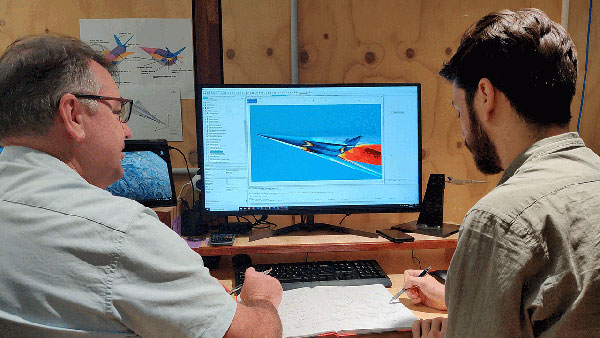
Dr. Stephen Hall (left) and Alexander Ward (right) of Brisbane-based aerospace engineering start-up, Hypersonix. Image courtesy of Siemens Digital Industries Software.
Latest News
November 19, 2021
Brisbane-based aerospace engineering start-up Hypersonix Launch Systems has chosen Siemens’ Xcelerator portfolio of software to help design its sustainable and reusable hypersonic launch vehicle, Delta-Velos. Hypersonix plans to implement advanced aerodynamic and thermal modeling software from Siemens’ Simcenter portfolio, which will play a role in building certainty and reliability of the launch vehicle responsible for placing small satellites into Low Earth Orbit once developed and in service. This is thought to be the first-time scramjet engines, whichwill be used for small satellite launch.
Hypersonix has recently also announced the opening of an office in Munich, Germany, also home to Siemens AG’s global headquarters. Hypersonix is developing a hypersonic, hydrogen fueled, unmanned space launch vehicle with its minimum viable product (MVP) version expected to launch in 23 months. Hypersonix has been gaining recognition for addressing atmospheric pollution caused by increasing rocket launches globally and their green, reusable SPARTAN scramjet engines that are powered by sustainable green hydrogen fuel.
“Software has levelled the playing field in what was previously an inaccessible space industry,” says Hypersonix Co-Founder and Managing Director David Waterhouse. “We now have the access and ability to not only give sustainable and innovative ideas life using simulation technologies, but also the opportunity to work collaboratively with global companies such as Siemens and tap into their expertise in advanced software for various industries.”
Siemens’ Simcenter STAR-CCM+ software will enable Hypersonix to perform multiple simulations of air-flow around its Delta-Velos launch vehicle. This will be used to simulate and digitally test the vehicle’s lift, drag and thrust, as well as the very high temperatures on its skin and structure. The software will also be used to model the complex, high-speed flows seen in scramjet engines and around hypersonic vehicles.
“Advanced simulation of this type is particularly important in the hypersonic flight regime because physical experiments are very difficult, if not impossible to perform. Everything must work on the first flight test. There is no room for error—and this digital simulation, or digital twin of the launch, means we can test everything in a virtual world and therefore achieve this high level of certainty and reliability. Simulations will enable our engineering team to perform multiple design studies to explore “what-if” scenarios and to fast-track the vehicle’s design which would normally have required many different codes involving months of work by multiple people,” adds Waterhouse.
Hypersonix’s fifth-generation green hydrogen-powered scramjet engine SPARTAN is capable of accelerating from Mach 5 to Mach 12; or five to 12 times the speed of sound. The Delta-Velos vehicle that features the SPARTAN engine will fly over 2500 km before landing like a conventional aircraft on a runway.
Dr Stephen Hall at Hypersonix first applied Siemens’ Simcenter STAR-CCM+ software to automotive applications when working for the Williams Formula 1 racing team in the UK. His experiences there heavily influenced Hypersonix’ decision to adopt the software.
“The strenuous competitive requirements of Formula 1 demonstrated the ability within Simcenter StarCCM+ to model complex flows around sophisticated vehicle geometries, while performing as a practical tool for rapid design iterations,” Hall says.
Siemens’ involvement in the project sees it join Boeing Research and Technology and BOC as major global companies playing a role in progressing the Delta-Velos project.
Samantha Murray, managing director of Siemens Digital Industries Software for the region, says the insights gained by using Siemens’ software provides for design exploration.
“Space is no longer just the domain of governments or large corporations. We take pride in the fact that it helps start-ups such as Hypersonix realize their dream,” Murray says. “When you are responsible for sending millions of dollars of equipment hurtling into space, you want to ensure it has been designed leveraging the same technology trusted by top aerospace companies around the world.”
Last year, Hypersonix received an Accelerating Commercialisation Grant from the Australian Federal Department of Industry, Science, Energy & Resources
Simcenter STAR-CCM+ is a multiphysics computational fluid dynamics (CFD) software for the simulation of products operating under real-world conditions.
More Siemens Digital Industries Software Coverage
Subscribe to our FREE magazine, FREE email newsletters or both!
Latest News
About the Author
DE’s editors contribute news and new product announcements to Digital Engineering.
Press releases may be sent to them via DE-Editors@digitaleng.news.
Related Topics






